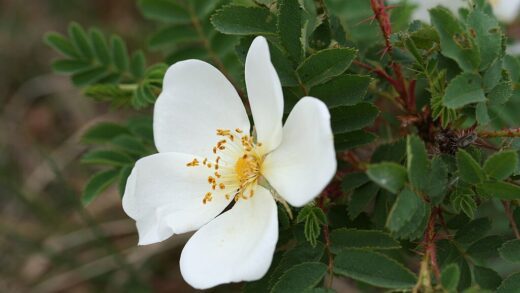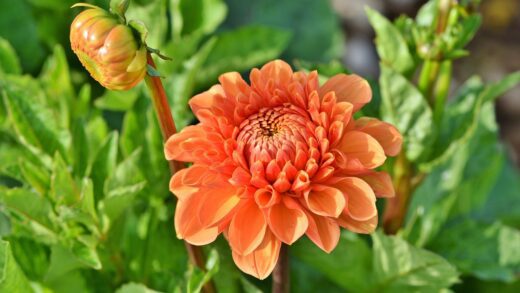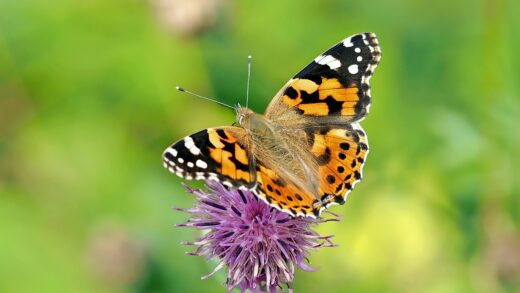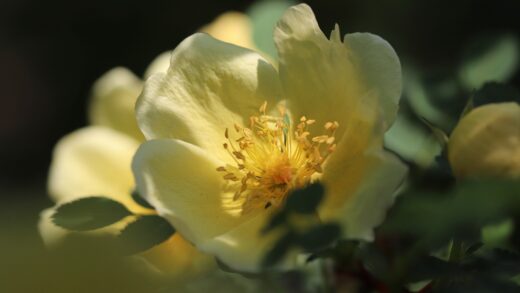While dahlias are generally robust and vigorous plants, they are not immune to the challenges posed by various diseases and pests. A watchful eye and a proactive approach are a gardener’s best defense against potential problems that can compromise the health and beauty of their blooms. Early detection and intervention are crucial, as a small issue can quickly escalate if left unchecked. By familiarizing yourself with the common culprits, from sap-sucking insects to fungal pathogens, you can implement effective management strategies that protect your plants and ensure a long and spectacular flowering season.
Integrated Pest Management (IPM) is a highly effective and environmentally sensitive approach to dealing with garden pests and diseases. This strategy emphasizes prevention and monitoring, and uses a combination of techniques to manage problems, rather than relying solely on chemical pesticides. Key principles of IPM include maintaining healthy soil, selecting disease-resistant varieties when possible, promoting good air circulation through proper spacing, and encouraging natural predators like ladybugs and lacewings into your garden. Regular inspection of your plants is the cornerstone of this approach, allowing you to identify and address issues at their earliest stages.
Among the most common pests to afflict dahlias are sap-sucking insects such as aphids, spider mites, and thrips. Aphids are small, soft-bodied insects that typically gather on the tender new growth and flower buds, causing distorted growth and excreting a sticky substance called honeydew, which can lead to sooty mold. Spider mites are tiny arachnids that thrive in hot, dry conditions, often found on the undersides of leaves, where they create fine webbing and cause a stippled, yellowed appearance. Thrips are miniscule, slender insects that damage flowers by feeding on the petals, resulting in silvery streaks and distorted blooms.
Slugs, snails, and earwigs represent another category of common dahlia pests, primarily causing damage by chewing on the foliage and flowers. Slugs and snails are particularly destructive to the tender young shoots emerging in the spring, capable of completely decimating a new plant overnight. Earwigs, while sometimes beneficial as predators, can also be a nuisance, chewing ragged holes in dahlia petals and hiding within the intricate layers of the blooms. Effective management of these pests often involves a combination of trapping, barriers, and baits.
Common fungal diseases
Fungal diseases are a prevalent issue for dahlias, particularly during periods of high humidity or prolonged wet weather. One of the most frequently encountered fungal problems is powdery mildew. This disease is easily identified by the characteristic white, powdery patches that appear on the surfaces of leaves, stems, and sometimes buds. While it rarely kills the plant, a severe infection can reduce its vigor, cause leaf distortion, and detract from its aesthetic appeal. Powdery mildew thrives in conditions of high humidity and poor air circulation.
To prevent powdery mildew, ensure that your dahlias are planted with adequate spacing to promote good airflow between them. Watering at the base of the plant using a soaker hose or drip irrigation, rather than overhead sprinklers, helps to keep the foliage dry and makes conditions less favorable for fungal spores to germinate. If an infection does occur, remove and destroy the most heavily affected leaves to reduce the spread of spores. For control, horticultural oils, neem oil, or fungicides containing potassium bicarbonate can be effective when applied according to the manufacturer’s instructions.
Another common fungal disease is botrytis, also known as grey mold. This disease typically affects the flowers and buds, especially during cool, wet weather. It appears as a fuzzy, greyish-brown mold that can cause the blooms to rot and turn slimy. It can also affect stems, causing them to collapse. Good garden hygiene is the best defense against botrytis. Promptly deadhead any spent or fading blooms, and remove any infected plant parts immediately to prevent the disease from spreading. Improving air circulation is also a key preventative measure.
Tuber rot is a serious issue that can occur either in the ground due to waterlogged soil or during winter storage. Several different fungal and bacterial pathogens can cause tubers to decay, turning them soft and mushy. The primary cause of tuber rot in the garden is poor drainage. Ensuring your dahlias are planted in well-drained soil is paramount. During storage, tubers must be properly cured and stored in a cool, dry, and well-ventilated location. Any tubers showing signs of rot should be discarded immediately to prevent the problem from spreading to healthy stock.
Common insect pests
A variety of insect pests can be drawn to dahlias, and recognizing them is the first step toward effective control. Aphids are one of the most common and are often found in dense colonies on the undersides of leaves and on tender new growth. Their feeding can cause leaves to curl and become distorted. A strong jet of water from a hose can be surprisingly effective at dislodging them. For more persistent infestations, applications of insecticidal soap or neem oil are excellent, less toxic options that are effective on contact but have minimal impact on beneficial insects once dry.
Spider mites are a significant pest, especially in hot, dry climates or in greenhouses. These tiny pests are difficult to see, but their damage, in the form of fine yellow stippling on the leaves and delicate webbing, is a clear indicator of their presence. Since they thrive in dry conditions, increasing the humidity around the plants by hosing down the foliage can help to deter them. Horticultural oils and insecticidal soaps are effective control measures, but they must be applied thoroughly to cover the undersides of the leaves where the mites congregate.
Thrips are another damaging pest, particularly for those who grow dahlias for cut flowers. These tiny insects feed by scraping the surface of the petals and leaves and sucking up the plant juices, which results in silvery or brownish streaks and distorted, discolored blooms. They can also transmit plant viruses. Controlling thrips can be challenging; removing infested blooms is a good first step. Predatory insects can provide some control, and in severe cases, insecticides specifically labeled for thrips may be necessary, although these should be used with caution to avoid harming pollinators.
Caterpillars, the larvae of various moths and butterflies, can also cause significant damage by chewing holes in the leaves and flowers of dahlias. Small infestations can often be managed by simply hand-picking the caterpillars off the plants. For larger outbreaks, products containing Bacillus thuringiensis (Bt), a naturally occurring bacterium that is toxic only to caterpillars, can be a very effective and environmentally friendly control option. Regular monitoring of your plants will help you to catch these pests before they can cause widespread damage.
Slugs, snails, and earwigs
Slugs and snails pose a significant threat to dahlias, especially in the spring when the tender new shoots are emerging from the ground. These mollusks are nocturnal feeders, and their tell-tale slime trails and the complete disappearance of young shoots overnight are clear signs of their activity. Protecting young plants during this vulnerable stage is critical. There are numerous methods of control, ranging from physical barriers to baits.
Creating a barrier around the base of the plants can be an effective deterrent. Coarse materials such as crushed eggshells, horticultural grit, or diatomaceous earth can discourage slugs and snails from crossing. Copper tape or rings placed around the base of plants or pots also work, as the slime of the mollusk reacts with the copper to create a small electric shock. These physical barriers need to be maintained, especially after rain, to remain effective.
Slug and snail baits are another popular option. Traditional baits containing metaldehyde are effective but can be toxic to pets and wildlife and should be used with extreme caution. A safer alternative is to use baits that contain iron phosphate as the active ingredient. These are effective at controlling slugs and snails but are non-toxic to other animals. Hand-picking the pests at night with the aid of a flashlight is another, albeit labor-intensive, method of control that can be very effective in small gardens.
Earwigs are a common nuisance for dahlia growers as they are attracted to the cool, dark, and moist environment within the numerous petals of a dahlia bloom. They feed at night, chewing ragged holes in the petals and sometimes the leaves. A simple and effective way to control earwigs is to create traps. Loosely rolled-up sections of newspaper or cardboard, or small pots stuffed with straw and placed upside down on stakes, provide an ideal daytime hiding place for them. In the morning, these traps can be collected and the earwigs disposed of.
Viral diseases and prevention
Viral diseases can be a serious problem for dahlias, and unlike fungal or bacterial diseases, there is no cure for an infected plant. Viruses are systemic, meaning they spread throughout the entire plant, including the tubers. Symptoms of a viral infection can be varied and may include mosaic patterns of light and dark green on the leaves, yellow streaks or spots, stunted or distorted growth, and a general lack of vigor. Infected plants often produce fewer and poorer quality flowers.
Viruses are most commonly spread from one plant to another by sap-sucking insects, such as aphids and thrips. As these insects feed on an infected plant, they pick up the virus in their mouthparts and then transmit it to the next healthy plant they feed on. Therefore, one of the most critical aspects of virus prevention is to effectively manage populations of these vector insects. Keeping your dahlias free from aphids and thrips will significantly reduce the risk of viruses spreading through your collection.
Another major mode of transmission is through contaminated tools. The virus can be spread via the plant sap left on tools like knives and secateurs. It is absolutely essential to practice good sanitation, especially when taking cuttings or dividing tubers. After working on each individual plant or tuber clump, you should thoroughly disinfect your tools using a solution of bleach, rubbing alcohol, or another horticultural disinfectant. This simple step can prevent the accidental spread of a virus from a single infected plant to your entire stock.
If you identify a plant that you suspect is infected with a virus, the most responsible course of action is to remove and destroy it immediately, including the tuber. Do not add it to your compost pile. While it may be difficult to discard a favorite variety, this is the only way to prevent the disease from spreading to the rest of your healthy plants. Always source new tubers from reputable suppliers, as this can also help to reduce the risk of introducing virally infected stock into your garden.
















